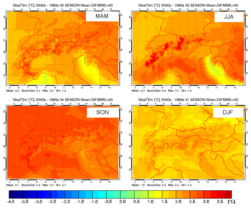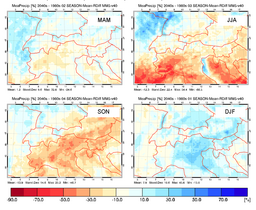reclip:more
| Project name: | reclip:more - Research for Climate Protection: Model Run Evaluation |
| Project leader: | Wolfgang Loibl (ARC systems research; overall project coordination) Andreas Gobiet (Uni Graz) |
| Project team: | Heimo Truhetz Andreas Riegler |
| Partners: | ARC systems research (project management) Inst. f. Met., Uni. of Nat. Ressources & Applied Life Sciences, Vienna Department of Meteorology and Geophysics, Univ. of Vienna ZAMG - Austrian Central Institute for Meteorology and Geodynamics, Vienna |
Sponsor: | ARC systems research, Wien |
| Duration: | Jan. 2003 - Jul. 2004 |
Abstract:
The 3-year project “Research for Climate Protection: Model Run Evaluation” (reclip:more) is a cooperation of five academic institutions in Austria (Austrian Research Centers Systems Research (ARC-sys), Department of Meteorology and Geophysics, Univ. of Vienna (IMG), Institute for Meteorology, Agricultural Univ. of Vienna (BOKU-Met), Central Institute for Meteorology and Geodynamics (ZAMG), and Wegener Center for Climate and Global Change, Univ. of Graz (WegCenter)) and is led by ARC-sys. The major aim of the project is to evaluate the capability of dynamical and statistical downscaling methods in the Alpine region and to create climate scenarios using dynamical, statistical, und diagnostic methods (10 km, 1km, 200m grid spacing) for latter use in climate impact research.
Two regional climate models (RCMs), ALADIN and MM5, are used for dynamical downscaling the ERA-40 reanalysis (period 1981-1990) and a global climate scenario of the ECHAM5 global circulation model (GCM) (periods 1981 – 1990 and 2041 – 2050) in order to reach regional-scale resolutions (10 km). Further downscaling to 1 km and finer grids of selected meteorological parameters is accomplished by statistical, geo-statistical, and diagnostic methods.
Results:
A reliable assessment of future climate impacts in Austria requires high resolution data sets for past and future climate, which shall be provided by reclip:more (Research for Climate Protection: Model Run Evaluation). The 3-year project is a cooperation of five academic institutions: ARC Systems Research GmbH (ARC-sys) who is leading the project, the Department of Meteorology and Geophysics, Univ. of Vienna (IMG), the Institute for Meteorology at the Univ. of Natural Resources and Applied Life Sciences (BOKU-Met), the Wegener Center for Climate and Global Change, Univ. of Graz (WegCenter) and the Central Institute for Meteorology and Geodynamics (ZAMG). The funding is provided by the Austrian Research Centers in the framework of the Kwiss-program to encourage university-non-university research cooperations.
The final objective of the project is to provide scientifically sound data sets for climate impact research on regional or local scale by including sufficient information to assess the results’ uncertainties. Thus climate scenarios at meso-scale resolutions (~10 km grid spacing) out of RCMs have been conducted. To achieve this, data preparations, a large set of common model experiments and their evaluation were carried out. Two regional circulation models (RCMs) - the French model ALADIN (http://www.cnrm.meteo.fr/aladin) and the US/Canadian MM5 (http://www.mmm.ucar.edu/mm5) - have been applied driven by ERA-40 reanalysis and ECHAM5 global circulation model (GCM) results to deliver current (1981-1990) and future (2041-2050) Alpine climate scenarios with high temporal resolution.


Reclip:more scenarios let estimate following variances: A change in annual mean temperature differences of + 2.2. K will be expected, the largest seasonal change could be in autumn with + 2.7 K and the lowest in winter with + 1.8 K (2041 – 2050 compared with 1981 – 1990) (see Tab. 1 and Fig. 1). In annual mean precipitation relative differences an increase of 4% will be expected (seasonal mean precipitation relative differences: + 13.9% in autumn and + 1.2% in spring) (see Tab. 2 and Fig. 2).
In summer and autumn, the Alpine ridge acts as a sharp barrier seperating drier conditions in the south from moister conditions in the north. The Austrian territory is strongest effected in winter (increasing of precipitation) and autumn (decreasing of precipitation) in the eastern part of the country.
Intensity of precipitation is increasing in winter, even in regions were frequency of precipitation is decreasing. Less rain days can be expected in summer and autumn over the entire Alpine region and in winter in the north-western part.
References:
Gobiet, A., H. Truhetz, A. Riegler,
A climate scenario for the Alpine region,
reclip:more project year 3 - WegCenter progress report, Wegener Center,
Univ. of Graz, Austria, 2006
[pdf (~1.5 MB)]
Gobiet, A., H. Truhetz, H. Formayer, M. Themessl, A. Riegler, and G.
Kirchengast,
High Resolution Climate Scenarios for Austria,
Proc. 9. Österr. Klimatag, March 2006, Vienna, Austria, V14, 2006
Gobiet A., H. Truhetz, and G. Kirchengast,
reclip:more: research for climate protection – model run evaluation,
IGAM Report Project Year 1,
Tech. Report for ARC-1/2004, IGAM, Univ. of Graz, Austria, 2004
[pdf (14 MB)]
Loibl, W., A. Beck, M. Dorninger, H. Formayer, A. Gobiet and W. Schöner
(Eds), reclip:more - research for climate protection: model run evaluation,
final report, ARC-sys-0123, Austrian Research Centers GmbH - ARC, Vienna, Austria, 2007
Loibl, W., A. Beck, M. Dorninger, H. Formayer, A. Gobiet, W. Schöner,
Kwiss-Programm reclip:more, research for climate protection: model run
evaluation, Project year 2 – Report 2005, ARC-sys, Vienna, Austria, 2006
Truhetz, H., A. Gobiet, and G. Kirchengast,
Evaluation of a dynamic-diagnostic modelling approach to generate highly
resolved wind fields in the Alpine region, Meteorol. Z., 16 (2), 191-201, doi: 10.1127/0941-2948/2007/0192, 2007
[pdf (~1.5 MB)]
Truhetz, H., A. Gobiet, and G. Kirchengast,
reclip:more-WegCenter Report #2 project year 2 (Nov 2004 – Oct 2005),
Tech. Report for ARC No. 1/2005, Wegener Center, Univ. of Graz, Austria, 2005
[pdf (~1.3 MB)]









